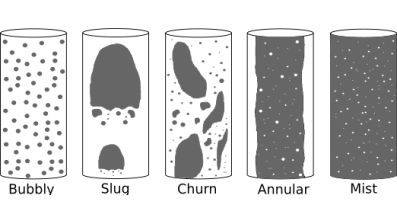Multiphase Pipe-Flow with an Application to Oil Wells
![]()
- Researcher: Victoria Pereira
- Academic Supervisors: Andrew Fowler and Andrew Thompson
- Industrial Supervisors: Garry Barclay and Kris Hayes
Background
Multiphase flow governs the simultaneous flow of multiple fluids in different physical states. Our motivating system is an oil well through which a mixture of water, oil, and gas flows. The difference between the high reservoir pressure and the lower pressure on the surface drives the flow up through the well. To model the system we assume a single liquid phase by averaging the oil and water. Through this, we can consider a two-phase liquid-gas flow through a pipe.
Mathematical modelling of multiphase mixtures is complicated by the interfacial effects between the different fluids. These systems are realised in a finite number of possible flow geometries, more commonly known as flow regimes, which are distinguished by their interfacial structures. Vertical two-phase liquid-gas flow can be categorised into five distinct flow regimes; bubbly, slug, churn, annular, and mist flow. The behaviour of the flow varies greatly between regimes and, to date, mathematical models have been predominantly developed for each flow regime. There is the question of what happens at the transition between these regimes.

We will study how new analytically tractable mathematical models can be developed to gain insight into the two-phase flow in oil wells, and in particular at the point of transition between flow regimes.
Outcomes
We have developed a homogeneous two-phase model that allows for gas exsolution. The model equations are derived from conservation of mass for a liquid phase, a gaseous phase and a dissolved gas concentration; and from conservation of momentum for the liquid and gaseous phases. The equations are closed by assuming equilibrium between the dissolved concentration of gas and the fluid pressure. The model yields simple but very unexpected results, which led us to consider non-equilibrium exsolution. Through this we have coupled the two-phase flow model with an evolution equation for a bubble size distribution which is driven by nucleating and growing bubble dynamics. The results of this work suggest that it is important to include non-equilibrium bubble dynamics when modelling exsolving flow in oil wells.
As the gas comes out of solution along the oil well, a bubbly flow is expected initially. As more gas is exsolved, the growing bubbles coalesce and eventually drive the bubbly flow to undergo a regime transition to slug flow. Slug flow is a common but undesirable occurence in oil wells; such a flow can cause damage to the equipment. We have used kinetic theory, analogous to the derivation of the Boltzmann equation, to develop a model for the evolution of a bubble distribution. We aim to understand how, where and why the flow regime transition occurs. It is generally understood that such a transition is the result of an instability of the flow dynamics. We will therefore use this model to study the sensitivity to parameters and stability of the flow bubble distribution.
Publications
[1] V. E. Pereira and A. C. Fowler. Exsolving two-phase flow in oil wells. (Submitted for publication)

